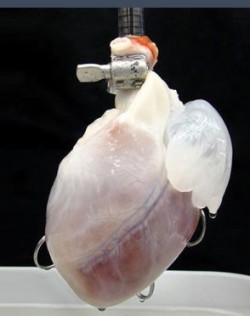By Ronda Wendler, Texas Medical Center News
The Texas Heart Institute and the veterinary medicine college at Texas A&M University will share a $3 million award from the state of Texas’ Emerging Technology Fund to create the Center for Cell and Organ Biotechnology.
“This center will play a key role in securing Texas’ very critical emerging role in biotechnology,” Gov. Rick Perry said at a Press Conference at the Heart Institute. “The sky is truly the limit for what this center will be able to accomplish.”
The new collaboration will focus on cell therapies and regenerative medicine, including building natural organs from stem cells.
Doris Taylor, Ph.D., who in 2008 created a beating rat heart at the University of Minnesota, was recruited to the Texas Heart Institute last year and will head the new center.
“Dr. Taylor is certainly one of the stars in the adult human stem cell field, and we feel extremely fortunate to have her,” said James Willerson, M.D., the Texas Heart Institute’s president and medical director.
Taylor is the developer of a technique known as decellularization, which involves stripping cells from an animal heart, leaving only a shell or scaffold of the heart in place, then infusing the scaffold with human stem cells to grow a new human heart.
At the Heart Institute, Taylor has created human heart models that are currently functioning at one-fourth capacity. She hopes to engineer a heart that functions at close to 100 percent capacity by 2015. The goal is to test such bioengineered hearts in clinical trials, probably in less than 10 years, she said, and eventually offer a solution to patients waiting for donor hearts, which are always in short supply.
Other scientists around the world are striving to do the same, and Texas Heart Institute founder Denton Cooley, M.D., said during the press conference that successful culmination of the institute’s efforts to engineer a human heart would be a fitting continuation of the heart institute’s legacy.
The decellularization approach is also being tried with other organs, Taylor said, including livers, kidneys and lungs.
Texas A&M’s College of Veterinary Medicine and Biomedical Sciences will contribute animal disease models to be used in cell therapy trials, as well as bioengineers who will build scaffolding upon which heart cells will grow. and experts in anatomy, physiology and stem cell science.
Scientists from the Heart Institute and Veterinary College will collaborate not only to grow new organs, but also to detect diseases earlier and to devise new cell and gene therapies to help prevent and treat diseases and injuries.
Texas A&M has more than 20,000 veterinary cases a year of animals with disease, and therefore will be invaluable in providing animals that can contribute to and benefit from this research, Taylor said.
Veterinarians and Heart Institute scientists will collaborate in other ways as well, she said. For example, racehorses with tendonitis are already being treated with stem cell therapy, and lessons learned could help human athletes. Doberman Pinschers routinely get heart disease and could benefit from the regenerative medicine efforts underway at the heart institute.
“It was clear from the beginning that this partnership was special,” said Eleanor Green, D.V.M., dean of A&M’s College of Veterinary Medicine and Biomedical Sciences. “We know that the health of animals and people is inextricably linked, and this unique center will advance both human and animal health.”
The state of Texas’ Emerging Technology Fund that funds the new center is a technology investment fund created at the urging of Gov. Rick Perry to give Texas an advantage in developing and commercializing emerging technologies. Launched in 2005, the fund has given out more than $200 million to startup companies and educational institutions.
The Texas Heart Institute’s next step, Taylor said, is to hire a technology transfer expert who will help form spin-off companies and commercialize its inventions.
Tags: organ transplants, organs from stem cells, stem cell benefits






